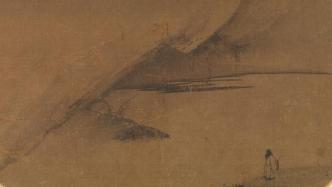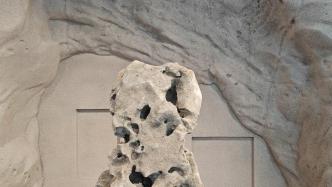
"Plum plums are beautiful when they are cold, bamboos are thin but long-lived, and stones are ugly but have writing. They are the friends of Sanyi." Su Dongpo of the Song Dynasty proposed in "Wen Yu Kemei, Bamboo and Stone" that when appreciating stones, "stones are ugly but have writing". The myriad shapes and forms of stone all come from this place. Recently, "Stones Are Ugly and Wearing: A Special Exhibition of Ancient Stone Appreciation Art" was opened at the West Lake Museum in Hangzhou. It displays traditional stone appreciation and stone paintings by many painters to recall Su Dongpo's influence on later generations of stone appreciation. This special exhibition lasts for two weeks. It is another Su Dongpo-related exhibition after the prestigious closing of "A Man Through the Ages - Su Dongpo Theme Cultural Relics Exhibition" at the West Lake Museum in Hangzhou. However, the theme focuses on Su Dongpo's unique contribution to the art of stone appreciation, showing The inheritance and development of the art of stone appreciation.
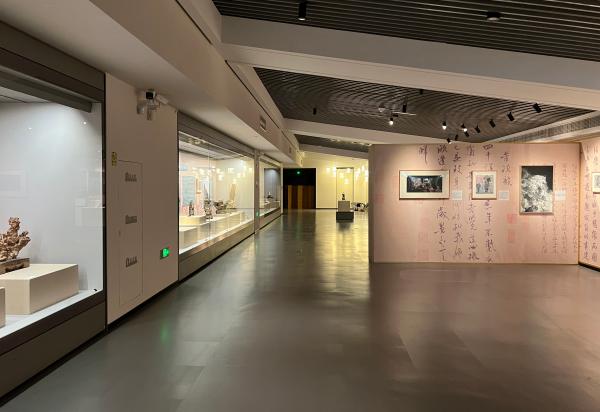
The scene of the special exhibition "Stones are Ugly and Written"
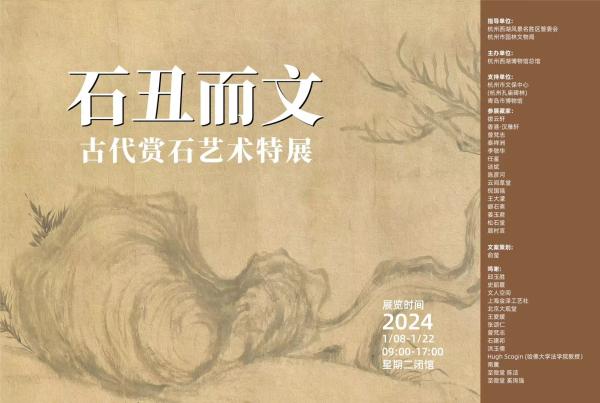
Poster for the special exhibition "Stones Are Ugly and Written"
According to the organizer, the exhibition is divided into four units: "West Lake Famous Stones and Su Shi", "Su Shi and Traditional Famous Stones", "Famous Stones Su Shi Appreciated", and "Yanshan and Study", with an exhibition area of 800 square meters. The well-known stone collector and owner of Bo Yunxuan invited more than ten well-known collectors and painters such as Hanart Tuan (Hong Kong), Zeng Fanzhi, Tai Xiangzhou, Wang Dameng, Bishizhai, Songshitang, Ni Guoqiang, Gu Cunyan, etc. Nearly one hundred pieces (groups) of collected stones and related artworks are on display. The exhibition also received assistance from the West Lake Museum, Hangzhou Cultural Preservation Center (Confucius Temple Stele Forest), Qingdao Museum and other units.
The theme of this exhibition, "Stones are ugly but literary", comes from Su Dongpo's "Wen and Plum Blossoms in Praise of Bamboo and Stone": "Plum blossoms are cold but beautiful, bamboos are thin but long-lived, stones are ugly but literary, they are friends of Sanyi." (Southern Song Dynasty· Luo Dajing's "Helin Jade Dew") Regarding "the stone is ugly but the text", later generations often misread it as "the stone is ugly but the text is ugly". This is what Zheng Banqiao's "Inscriptions on Stone" quoted in the Qing Dynasty - "Mi Yuanzhang" When talking about stone, it is said to be thin, crepe (wrinkled), leaky, and transparent, which can be said to be the most wonderful thing about stone. Dongpo also said: "The stone is ugly". The word "ugly" means that the stone has thousands of shapes, all from this Come out." This is actually a misunderstanding, and the two have different meanings. Judging from the context in Su Dongpo's "Wen Yu Kemei, Bamboo and Stone", there is no doubt that "the stone is ugly and the article is written" is accurate, and can be interpreted as: the more grotesque and ugly the stone, the more elegant it is. There is no doubt that the meaning of "the stone is ugly but the writing" is more connotative and subtle than the meaning of "the stone is ugly but the writing is ugly". The so-called ugly rocks not only refer to an incredible abstract state, but also refer to an anti-artificial order and anti-formal beauty.

"Dongpo Playing with Inkstones" by Huang Shen of the Qing Dynasty, collected by the Palace Museum (Note: not included in this exhibit) The Paper News Materials

Su Shi's "Sea Crossing Tie", collected by the National Palace Museum in Taipei (not included in The Paper news materials for this exhibition)
It is worth pointing out that it is said that Mi Fu's skinny wrinkles revealed the "Xiangshi method", which was traced or followed by people after the Song Dynasty. Moreover, Mi Fu and Su Dongpo were fifteen years old. From the perspective of the timeline, "Shi Chou Er Wen" should be at the forefront. In other words, the so-called thin, wrinkled and leaky is just a collective interpretation of "ugly", but it does not cover all. Therefore, Su Dongpo's "stones are ugly but literary" is a high-level summary of the traditional aesthetics of stone appreciation, which is more general and open than the thin, wrinkled and revealing theory. Liu Xizai, a modern literary and art critic, summed up the final meaning: "Strange rocks are beautiful because of their ugliness. When they are extremely ugly, they are extremely beautiful. The word 'ugly' cannot easily describe the beauty of the rocks." ("Summary of the Arts") •Book Summary)
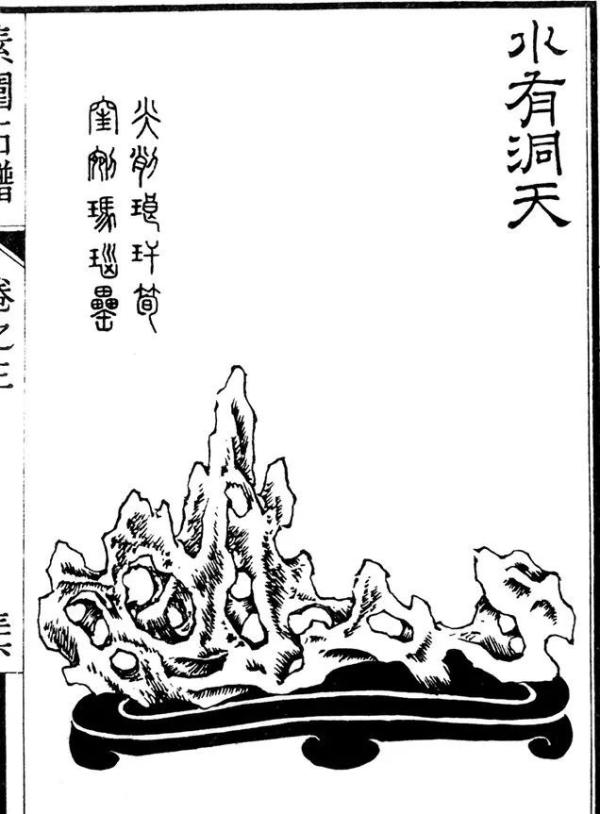
Stone appreciation from Ming and Qing engraved editions The Paper News Materials
The traditional ornamental stones in this exhibition include Taihu stone, Lingbi stone, Yingshi, Qingzhou stone, Xuelang stone, Laoshan stone, yellow wax stone, Xuan stone, red silk stone, chrysanthemum stone, pine stone, Xuan stone, marble, Rain flower stones, stalactites, crystals, natural copper, and tree roots of various materials, as well as many painters' stone paintings, including calamus with stones, are all in great variety, making it a magnificent sight. Among them, Taihu stone, Lingbi stone, Yingshi, Qingzhou stone, Xuelang stone and other stone types were mostly collected or chanted by Su Dongpo at that time. Su Dongpo can be called an all-around master of stone appreciation. He left nearly a hundred poems about stone appreciation and was the literati who wrote the most poems about stone in ancient times. Moreover, many of Su Dongpo's stone appreciation activities were groundbreaking and had a profound impact on later generations.

Lingbi stone inkstone on display
For example, when Su Dongpo was twelve years old, he discovered the "Tianshi Inkstone" in the open space of his hometown (later he wrote "Tianshi Inkstone (Combined Narrative)"). The so-called Tianshi Inkstone is actually a natural strange stone inkstone. This was Su Dongpo's earliest collection. Appreciate stones. Later, the celestial inkstone also became a style of inkstone - also a unique style in modern stone appreciation. In the Southern Song Dynasty, Gao Sisun's "Inkstone Notes" (Volume 1) included "Celestial Inkstone" in the introduction to the style of inkstone pictures. ". Gao Lian's "Eight Notes of Zunsheng" of the Ming Dynasty also included a picture of "Lingbi Mountain Stone Inkstone" (from the "Ke Jingzhong Collection" of the Yuan Dynasty). In this exhibition, there is a "Lingbi Stone Tian Inkstone" (collected by Puyunxuan), which is a naturally shaped Lingbi stone with raised black pearl patterns around it and an inkstone in the middle. It is similar to the "Lingbi Mountain Stone Inkstone" from "Eight Notes of Zunsheng". "It's exactly the same, it can be said to be a perfect appreciation stone.
There are not only those who appreciate the stones at the exhibition, but also those who appreciate them in paintings. Interestingly, almost all the participating painters (Zeng Fanzhi, Tai Xiangzhou, Chen Yanhe, Li Jinghua, Jiang Yujun, Gu Cunyan) have stones in their collections. For example, the contemporary artist Zeng Fanzhi has a collection of ancient ornamental stones, and he once collaborated with Huang Xuanlong, a famous collector of cultural objects in Taiwan, to create the "Large Mountain Scroll" using 22 ancient inkstones collected in Jiansong Pavilion as materials. This group of "Ten Thousand Miles" "The Picture of Rivers and Mountains" was unveiled at the auction in December 2016. It is quite creative and impressive. In this exhibition, one of Zeng Fanzhi's stone paintings, "The Fifth Stone Between the Clouds", debuts. It depicts the image of a square stone inkstone (collected by Bo Yun Xuan). It is made of ink on paper and is both realistic and freehand. It is both classical and contemporary. Very rare.
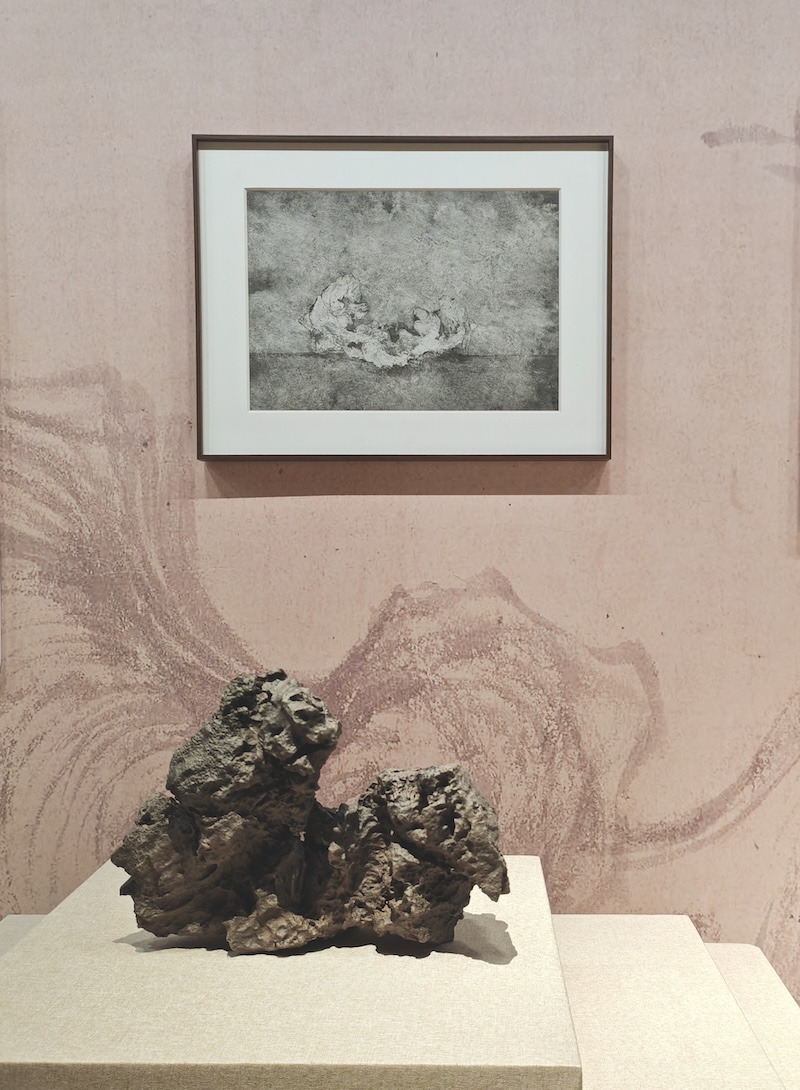
Exhibition site, Zeng Fanzhi's "The Fifth Stone Between Clouds" and Yingshi Shanzi
The "Four Famous Stones" are the most common among traditional stone appreciation. At the entrance of the exhibition, there is a "Taihu Stone Mountain Son" (caught in Bo Yun Xuan). It is full of orifices and can be seen from all sides. It is full of old-fashioned spirit and extraordinary magnanimity. It is reminiscent of Bai Juyi's famous line praising Taihu Stone: "It is scattered across Cui Wei and the sky is blue." There is a pile of jade. The peak parallel fairy palm emerges, and the sword door opens." Qingzhou stone belongs to Taihu stone (North Taihu stone), and its expressive power is no less than that of Taihu stone. In this exhibition, there are many Qingzhou stones on display, such as the "Qingzhou Stone Mountain Son" (Chen Yanhe Collection), which is full of clouds and rain, and is very leaky. It can be said that it is not like Taihu Lake, but better than Taihu Lake.
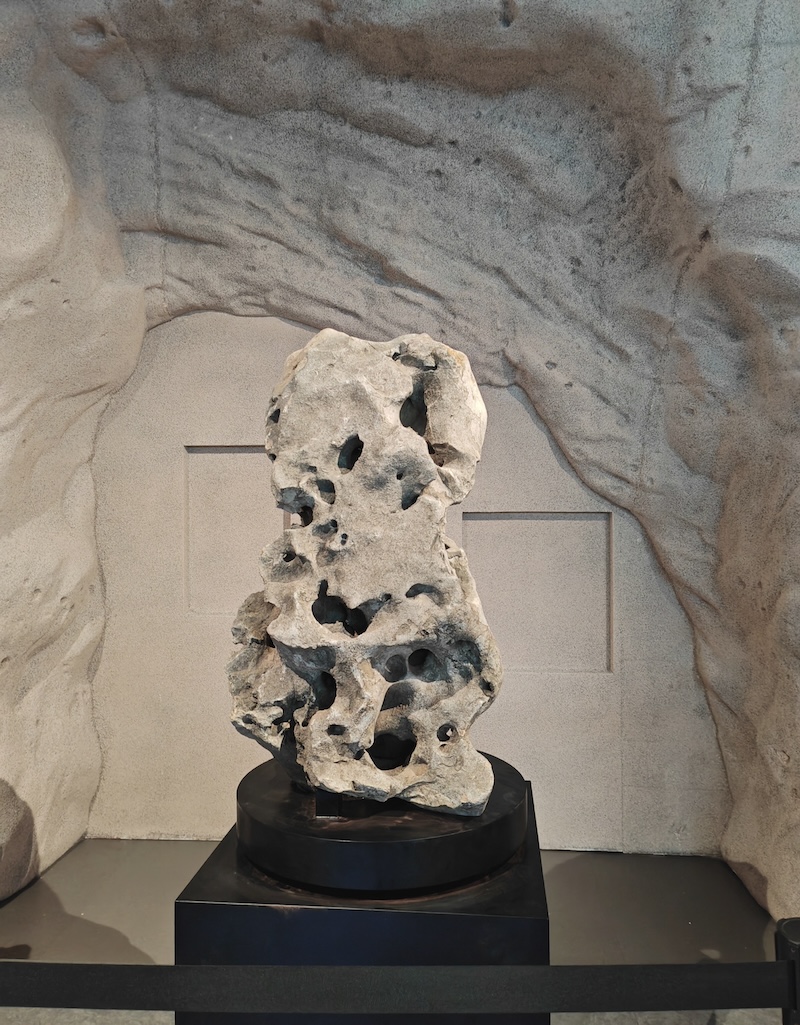
Exhibition site, Taihu Shishanzi
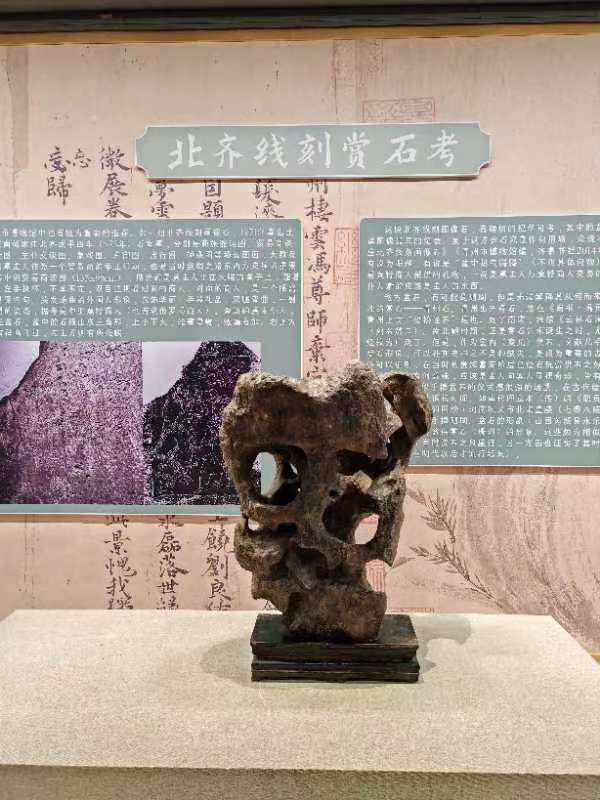
Qingzhou Shishanzi
Lingbi stone and Yingshi are often mentioned on the same level as top-grade stone offerings in ancient times, and can be called the "Twin Stars". There is a "Lingbi stone fish-shaped chime" (from the collection of Feishizhai). It is naturally shaped like a mandarin fish, moistened with pulp, and hung on the gantry. More than enough. In ancient times, chime materials were mostly taken from Lingbi chime stone, which has excellent texture and produces the sound of gold and jade when struck. The sound is better than other stone types. However, it is often processed into a curved ruler shape, and the raw stone is used (especially fish-shaped ones). Making chimes is not common. Su Dongpo wrote the poem "Inscribed on the stone chime of Yunlong Caotang": "It is folded into the waist of the governor's post and hung as a mountain man's room. It is not the sound of Pushang, but it is believed to be Sibin stone." The square stone chime in the poem should be processed into a curved ruler shape. Lingbi stone. Yingshi is often known for its thin wrinkles. One side of the "Yingshi Inkstone" (collected by Hanya Gallery, Hong Kong) has a dark coating, a natural and stable bottom, towering peaks, scattered heights, full of rhythm, extremely varied texture, and can be viewed from both sides. , allowed to be called top grade.
Fossilized pine is an alternative to traditional stone appreciation. It became famous in the late Tang Dynasty, hundreds of years earlier than the West's understanding of petrified wood. During the Tang, Song, Yuan, Ming and Qing dynasties, records of fossilized pine trees lasted for a long time. The ancestors of Kangxi and Qianlong in the Qing Dynasty also liked fossilized pine trees, especially the fossilized wood produced in the Kanggan River area in the northeast of the "Longxing Land". Kangxi had an imperial text entitled "Petrified Wood", and Qianlong also wrote many poems praising it. There are still three Qing Dynasty wood fossils in the Forbidden City. There are several ancient pine fossil origins, especially those in Yongkang, Zhejiang. The poet Lu Guimeng's "Second Poems (with Preface)" says: "Who can see the towering sky from the bottom of his hair, and then reach the age of pale fossils. The breeze of all ages blows, and a piece of The cold drops form a river." For thousands of years, Yongkang pine fossils have been spread in an orderly manner, and viewing pine fossils has become an important part of local folk customs.
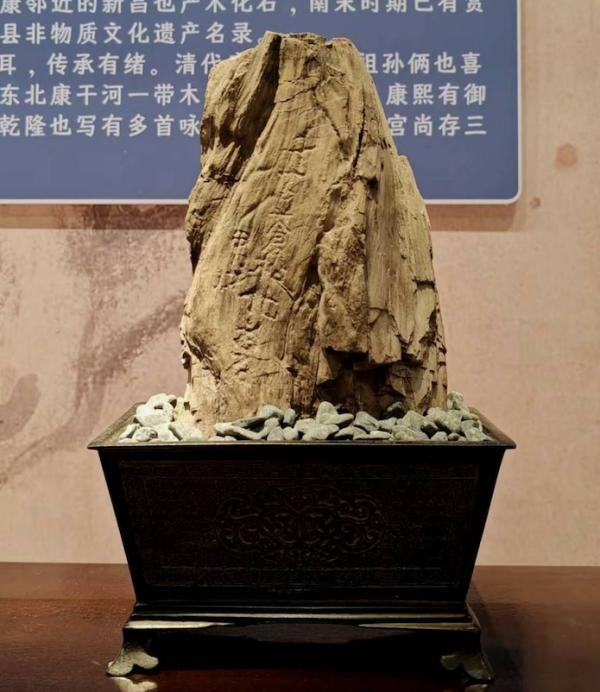
Exhibition site, Yongkang Songshi
The Yongkang pine stone on display this time, "Eternal Pines Turned into Stone" (collected by Songshi Hall), was discovered in 1992. It is a pine trunk with clear bark texture and is covered with pulp. The stone is engraved with regular script verses and The chronological inscription: "Eternal pines turned into stone. Jiaxu". Pine stones with similar chronological inscriptions are extremely rare. It is worth remembering that on the occasion of the opening of this exhibition, "Yongkang Pine and Stone Art" was successfully included in the Yongkang City Intangible Cultural Heritage List.
Calamus has always been regarded as a "literati's grass" because of its characteristics of "no color, no need for an inch of soil" and the ability to survive the winter and live for hundreds of years. At least in the Song Dynasty, it has been popular among literati circles for cultivation. Su Dongpo was an advocate of planting calamus with stones. He praised calamus for "bearing the cold and suffering, being indifferent, living with the clear springs and white rocks, and growing without waiting for the soil" ("Ode to the Stone Calamus (Combined Narrative)"). He liked to plant calamus with stones, "to grow it with colorful jade." Calamus, a spoonful of clear spring fills the stone bowl." ("Guo Wenjue Xian Gongfang"). Raising cattails has become a grand event in recent years and has entered the homes of ordinary people. Mr. Wang Dameng of Wuxi is a follower of Su Dongpo who planted cattails on stones. He deeply explored the deeds and experiences of ancient celebrities in raising cattails, carved stone inscriptions, made pots and made paintings, which was unique and spectacular. This exhibition shows a group of cattail plants planted by Mr. Wang Dameng, which is also very interesting.
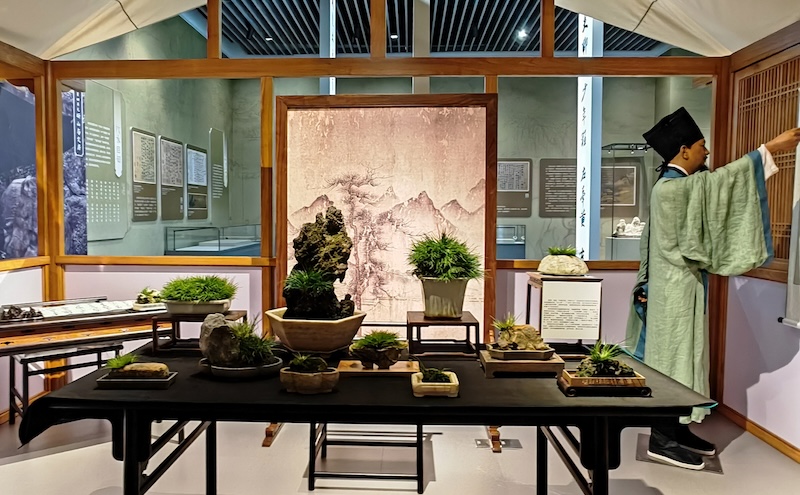
Mr. Wang Dameng’s group planted cattails
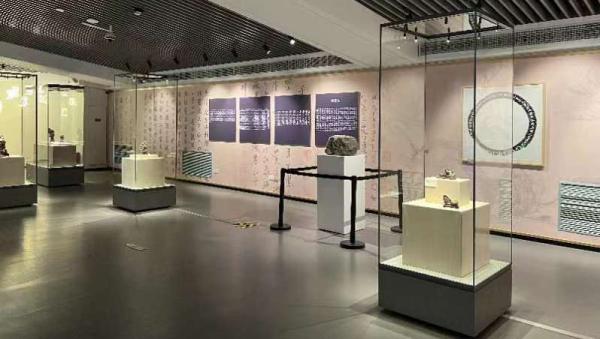
Exhibition site
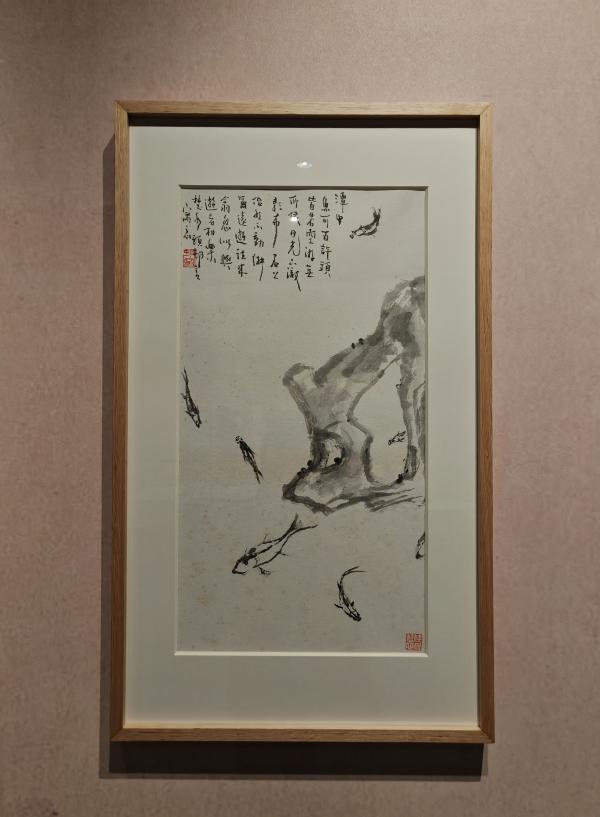
Exhibition scene, Gu Cunyan's "Stone and Fish"
If "when talking about paintings, we should look at shapes and see children as neighbors" is Su Dongpo's declaration on "literati paintings", then "stones are ugly but elegant" is like the poet's declaration on traditional stone appreciation ("literati stones"). The ancients valued the meaning of stones when appreciating them, but they did not exclude pictograms. For example, Su Dongpo's postscript "Calligraphy and Painting Wall Yi Shi" tells the story of him painting on the pink wall of Liu's Garden, a Lingbi stone. He found that the owner had a piece of Lingbi stone "shaped like an elk's neck." The layman Dongpo wanted to get it, so he painted it Linhua Pavilion wall was made of ugly stone and wind bamboo. The owner was so happy that he left it to him." This Lingbi stone, which looked like a deer looking back, was finally brought back to Yixing by the poet happily - in the eighth year of Yuanfeng, Shenzong of the Song Dynasty ( 1085) April 6th. This is not only a story about the poet changing the stone by painting, but also an important page in the cultural history of Lingbi stone collection. In this exhibition, there is a large piece of Lingbi stone. The whole shape is like an elk looking back. It is very vivid and full of tension. The owner of Bo Yunxuan named it "Elk Wan Neck", which is also a tribute to Po Weng.
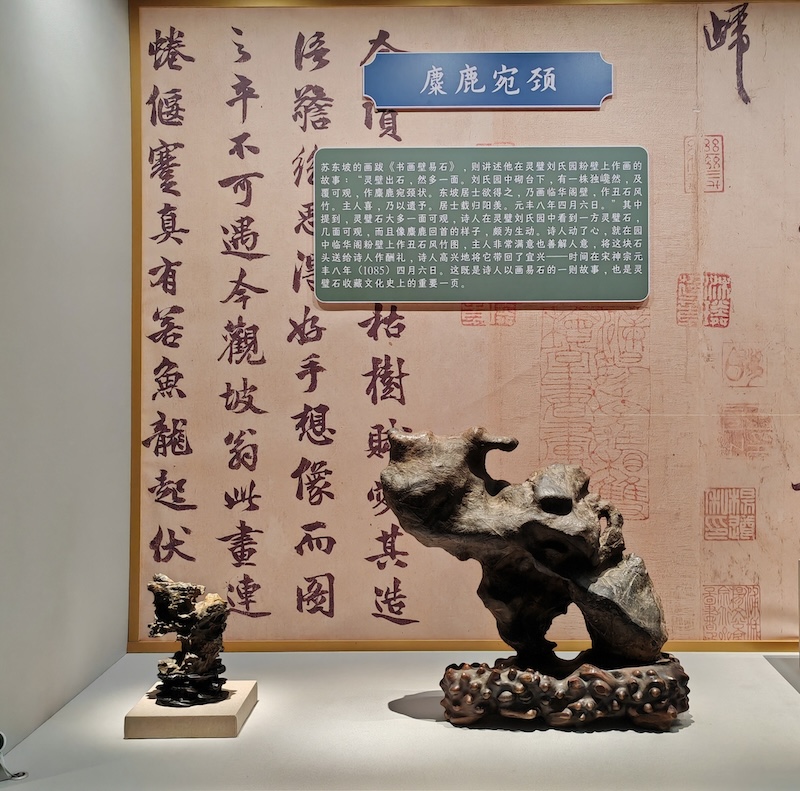
Lingbi stone "elk neck"
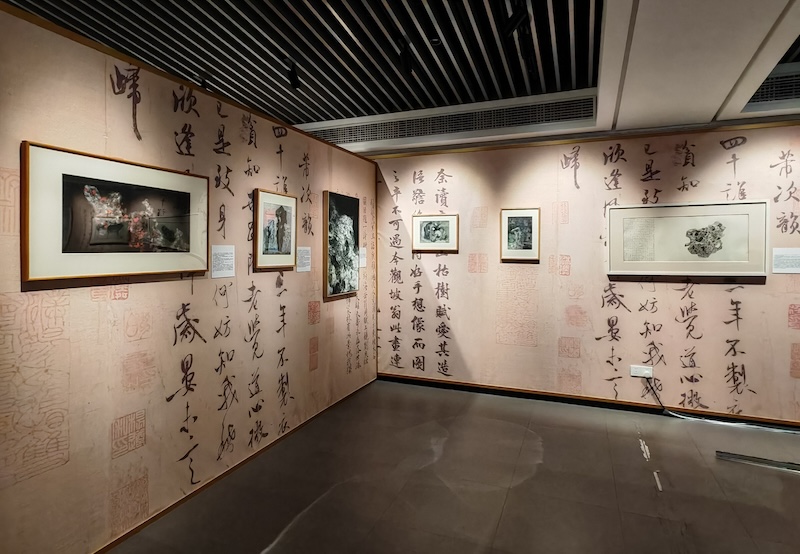
Painter's Stone Exhibition Area
(Note: The original title of this article is "Traditional Stone Appreciation and Sword Discussion at West Lake")


